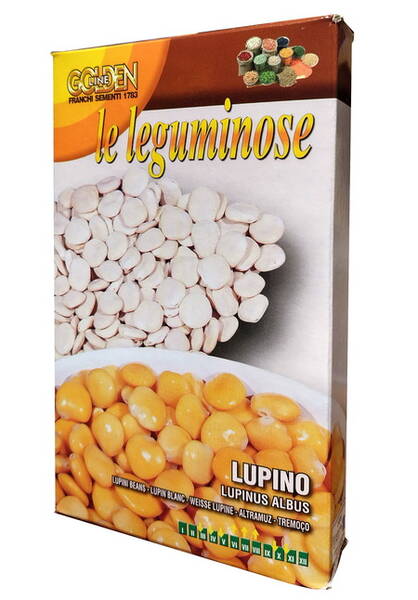An ideal green manure that saturates the soil with organic matter and structures it to a great depth: it enriches the soil not only with nitrogen, but also with phosphorus in a form available to plants (unlike other legumes).
A high-yielding variety of fodder annual lupine, which is also used as an effective green manure-nitrogen fixer.
Seedlings withstand frosts down to -4-5°C.
The plant is photophilous and drought-resistant, does not impose special requirements on soil fertility, is able to grow on clay, sandy and sandy loamy soils with a neutral or slightly acidic reaction.
The duration of the growing season depends on the place of cultivation and weather conditions: it ranges from 90-175 days.
The culture is a good nitrogen fixer: the plant accumulates more than 40-50 tons of nitrogen per 1 hectare. It is cultivated as a green manure and also as a leguminous crop.
Lupine seeds are large: with such a supply of nutrients, the plant sprouts quickly, grows quickly and does not allow weeds to "crush" itself.
* The main advantage of this culture is the biological ability to grow and develop well on very poor sandy soils.
* Lupine is not picky about heat and moisture (the areola of its distribution is much wider than that of soybeans): it can be effectively grown in almost all regions of risky farming (and even beyond the Arctic Circle).
* Lupine roots penetrate the soil to a depth of 2.5 m and loosen it, being a good structure former (due to which, after lupine, many vegetables can be sown directly without additional tillage).
* Lupine is a unique plant with a high nitrogen-fixing and phosphate-mobilizing capacity.
It provides natural enrichment of soils with nitrogen, leaving more than 100 kg of mineral nitrogen easily absorbed by plants per hectare and thereby increasing soil fertility.
The fact is that lupine, with its roots, breaks down immobile phosphorus compounds (even those that lie in deep layers) and converts up to 100 kg of P2 O5 and up to 200 kg of K2O into an accessible form. In sum, this is equivalent to applying 300 kg/ha ammonium nitrate and 400 kg/ha ammophoska (16:16:16).
* By absorbing nitrogen from the atmosphere, lupine ensures its uniform distribution throughout the field (while expensive nitrogen fertilizers are distributed unevenly and are not completely absorbed by plants).
* Lupine well neutralizes acidified soil: in three rotations, without the use of soil deoxidizers, it is possible to reach pH = 6.0, that is, almost approach neutral.
* The cost of growing lupine grain is 2 times lower than soybean grain, so lupine is an alternative source of fodder and food vegetable protein.
* The yield of lupine is about 5 times higher than that of soybeans.
* In terms of protein content, lupine grain surpasses soybeans and other legumes: its grain contains from 32 to 38% protein, up to 15% fat, carotenoids (with 90% represented by carotene), tocopherol, dietary fiber and minerals.
Attention: all legumes contain anti-alimentary (anti-food) substances - compounds that block or impair the absorption of nutrients, therefore, the use of lupine grain for food and feed purposes is restrained due to the high content of anti-alimentary substances in it - alkaloids that add bitterness to the product obtained from its seeds.












